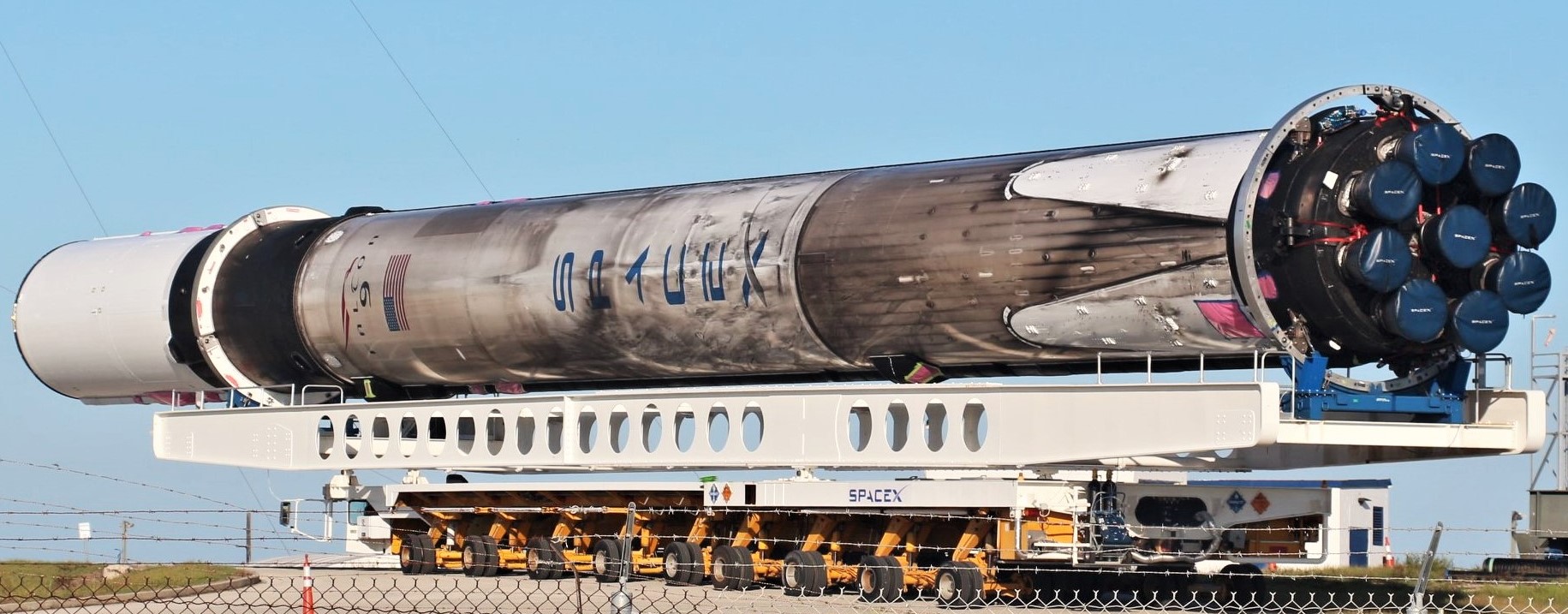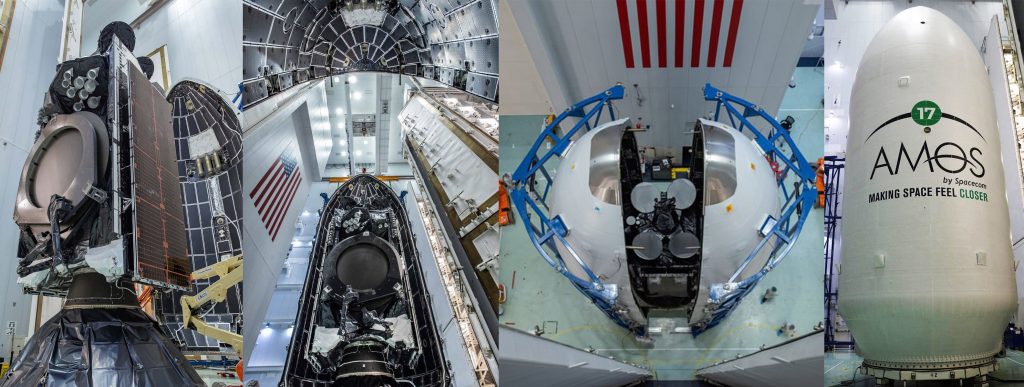

News
SpaceX transports Falcon 9 to launch site ahead of Block 5’s second expendable launch ever
Photos published on July 28th by customer Spacecom show a sooty SpaceX Falcon 9 booster and fresh upper stage on their way to LC-40 for the launch of the AMOS-17 communications satellite, scheduled to lift off no earlier than 6:51 pm EDT (22:51 UTC), August 3rd.
Sadly, the booster will reportedly be expended during the launch. According to Spacecom, AMOS-17 – built by Boeing – is an undeniably large satellite, weighing more than 6500 kg (14,300 lb) and featuring a solar array wingspan of ~35m (115 ft). SpaceX has certainly launched larger satellites than AMOS-17 and still recovered their Falcon 9 boosters, but this mission is somewhat unique and SpaceX is obviously willing to go the extra mile in this case.
In a surprise development, Spacecom officially confirmed that AMOS-17 will be SpaceX’s second expendable Falcon 9 Block 5 launch in the rocket’s ~15 months of operations, following in the footsteps of its expendable December 2018 launch debut. This is more than a little disappointing, thanks in large part to the fact that SpaceX has developed Falcon 9 (and Heavy) reusability to such a level of maturity that fully expendable Falcon launches just feel wrong.
In fact, just a month ago, SpaceX reached a major milestone of reusability when it recovered two flight-proven Falcon Heavy boosters and became the first company in history to launch and land more orbital-class rocket boosters than it has expended (as of June 2019: 81 launched, 43 landed). SpaceX followed this up with landing #44 after Falcon 9 B1056.2 successfully completed its second launch on July 25th.
While expending a Block 5 booster that SpaceX CEO Elon Musk has stated could launch upwards of 20-30 times is certainly disappointing, the sting of Block 5’s second expendable mission is at least soothed by the knowledge that it will be this booster’s third and final launch. The first expendable Block 5 launch – the US Air Force’s GPS III SV01 mission – made use of a brand new booster (B1054).
A (hopefully) worthy sacrifice
In a small way, Falcon 9 B1047’s premature demise could easily be viewed as a sort of symbolic eye-for-an-eye sacrifice. Although not a literal 1:1 replacement, AMOS-17 is still essentially a follow-on to Amos-6, destroyed on September 1st, 2016 when Falcon 9 suffered an exotic COPV failure that led to a massive explosion (Musk called it a ‘fast fire’).
Installed on top of the rocket during what was meant to be a pre-launch static fire test, the ~$200M+ Amos-6 satellite was not spared from the destruction and owner Spacecom ultimately received an insurance settlement it then used (in part) to purchase AMOS-17. Additionally, instead of accepting a cash payout from SpaceX, Spacecom chose the contractual alternative: a free Falcon 9 launch of their choice.
Is it a coincidence that a Block 5 booster is going to be expended as part of that replacement launch? Almost certainly, yes. At a minimum, SpaceX – essentially launching for free per a contractual agreement with Spacecom – has clearly decided along with Spacecom that putting all of Falcon 9’s energy into AMOS-17 is preferable to withholding margin for a landing.

With Falcon 9 B1047.2 in an expendable configuration, SpaceX can take a no-holds-barred approach towards delivering Spacecom’s AMOS-17 to the highest orbit possible. The higher the geostationary transfer orbit (GTO) Falcon 9 can launch AMOS-17 to, the faster the satellite can begin serving customers and thus generating revenue for Spacecom. Combined with the fact that more than half of AMOS-17’s massive 6.5-ton mass is chemical propellant, the spacecraft – pending a healthy launch and on-orbit commissioning – could be ready to start serving customers just a month or two after lift-off.
Falcon 9 B1047 will be missed, but the booster’s demise is an understandable cost of SpaceX prioritizing customer Spacecom’s launch experience above the company’s own best interests.
Check out Teslarati’s Marketplace! We offer Tesla accessories, including for the Tesla Cybertruck and Tesla Model 3.
News
Tesla begins Robotaxi certification push in Arizona: report
Tesla seems serious about expanding its Robotaxi service to several states in the coming months.

Tesla has initiated discussions with Arizona transportation regulators to certify its driverless Robotaxi service in the state, as per a recent report from Bloomberg News. The move follows Tesla’s launch of its Robotaxi pilot program in Austin, Texas, as well as CEO Elon Musk’s recent comments about the service’s expansion in the Bay Area.
The Arizona Department of Transportation confirmed to Bloomberg that Tesla has reached out to begin the certification process for autonomous ride-sharing operations in the state. While details remain limited, the outreach suggests that Tesla is serious about expanding its driverless Robotaxi service to several territories in the coming months.
The Arizona development comes as Tesla prepares to expand its service area in Austin this weekend, as per CEO Elon Musk in a post on X. Musk also stated that Tesla is targeting the San Francisco Bay Area as its next major market, with a potential launch “in a month or two,” pending regulatory approvals.
Tesla first launched its autonomous ride-hailing program on June 22 in Austin with a small fleet of Model Y vehicles, accompanied by a Tesla employee in the passenger seat to monitor safety. While still classified as a test, Musk has said the program will expand to about 1,000 vehicles in the coming months. Tesla will later upgrade its Robotaxi fleet with the Cyercab, a two-seater that is designed without a steering wheel.
Sightings of Cybercab castings around the Giga Texas complex suggests that Tesla may be ramping the initial trial production of the self-driving two-seater. Tesla, for its part, has noted in the past that volume production of the Cybercab is expected to start sometime next year.
In California, Tesla has already applied for a transportation charter-party carrier permit from the state’s Public Utilities Commission. The company is reportedly taking a phased approach to operating in California, with the Robotaxi service starting with pre-arranged rides for employees in vehicles with safety drivers.
News
Tesla sets November 6 date for 2025 Annual Shareholder Meeting
The automaker announced the date on Thursday in a Form 8-K.

Tesla has scheduled its 2025 annual shareholder meeting for November 6, addressing investor concerns that the company was nearing a legal deadline to hold the event.
The automaker announced the date on Thursday in a Form 8-K submitted to the United States Securities and Exchange Commission (SEC). The company also listed a new proposal submission deadline of July 31 for items to be included in the proxy statement.
Tesla’s announcement followed calls from a group of 27 shareholders, including the leaders of large public pension funds, which urged Tesla’s board to formally set the meeting date, as noted in a report from The Wall Street Journal.
The group noted that under Texas law, where Tesla is now incorporated, companies must hold annual meetings within 13 months of the last one if requested by shareholders. Tesla’s previous annual shareholder meeting was held on June 13, 2024, which placed the July 13 deadline in focus.
Tesla originally stated in its 2024 annual report that it would file its proxy statement by the end of April. However, an amended filing on April 30 indicated that the Board of Directors had not yet finalized a meeting date, at least at the time.
The April filing also confirmed that Tesla’s board had formed a special committee to evaluate certain matters related to CEO Elon Musk’s compensation plan. Musk’s CEO performance award remains at the center of a lengthy legal dispute in Delaware, Tesla’s former state of incorporation.
Due to the aftermath of Musk’s legal dispute about his compensation plan in Delaware, he has not been paid for his work at Tesla for several years. Musk, for his part, has noted that he is more concerned about his voting stake in Tesla than his actual salary.
At last year’s annual meeting, TSLA shareholders voted to reapprove Elon Musk’s compensation plan and ratified Tesla’s decision to relocate its legal domicile from Delaware to Texas.
Elon Musk
Grok coming to Tesla vehicles next week “at the latest:” Elon Musk
Grok’s rollout to Tesla vehicles is expected to begin next week at the latest.

Elon Musk announced on Thursday that Grok, the large language model developed by his startup xAI, will soon be available in Tesla vehicles. Grok’s rollout to Tesla vehicles is expected to begin next week at the latest, further deepening the ties between the two Elon Musk-led companies.
Tesla–xAI synergy
Musk confirmed the news on X shortly after livestreaming the release of Grok 4, xAI’s latest large language model. “Grok is coming to Tesla vehicles very soon. Next week at the latest,” Musk wrote in a post on social media platform X.
During the livestream, Musk and several members of the xAI team highlighted several upgrades to Grok 4’s voice capabilities and performance metrics, positioning the LLM as competitive with top-tier models from OpenAI and Google.
The in-vehicle integration of Grok marks a new chapter in Tesla’s AI development. While Tesla has long relied on in-house systems for autonomous driving and energy optimization, Grok’s integration would introduce conversational AI directly into its vehicles’ user experience. This integration could potentially improve customer interaction inside Tesla vehicles.
xAI and Tesla’s collaborative footprint
Grok’s upcoming rollout to Tesla vehicles adds to a growing business relationship between Tesla and xAI. Earlier this year, Tesla disclosed that it generated $198.3 million in revenue from commercial, consulting, and support agreements with xAI, as noted in a report from Bloomberg News. A large portion of that amount, however, came from the sale of Megapack energy storage systems to the artificial intelligence startup.
In July 2023, Musk polled X users about whether Tesla should invest $5 billion in xAI. While no formal investment has been made so far, 68% of poll participants voted yes, and Musk has since stated that the idea would be discussed with Tesla’s board.
-

 Elon Musk2 weeks ago
Elon Musk2 weeks agoTesla investors will be shocked by Jim Cramer’s latest assessment
-

 Elon Musk1 day ago
Elon Musk1 day agoxAI launches Grok 4 with new $300/month SuperGrok Heavy subscription
-

 Elon Musk3 days ago
Elon Musk3 days agoElon Musk confirms Grok 4 launch on July 9 with livestream event
-

 News1 week ago
News1 week agoTesla Model 3 ranks as the safest new car in Europe for 2025, per Euro NCAP tests
-

 Elon Musk2 weeks ago
Elon Musk2 weeks agoA Tesla just delivered itself to a customer autonomously, Elon Musk confirms
-

 Elon Musk1 week ago
Elon Musk1 week agoxAI’s Memphis data center receives air permit despite community criticism
-

 Elon Musk2 weeks ago
Elon Musk2 weeks agoTesla’s Omead Afshar, known as Elon Musk’s right-hand man, leaves company: reports
-

 News2 weeks ago
News2 weeks agoXiaomi CEO congratulates Tesla on first FSD delivery: “We have to continue learning!”



















